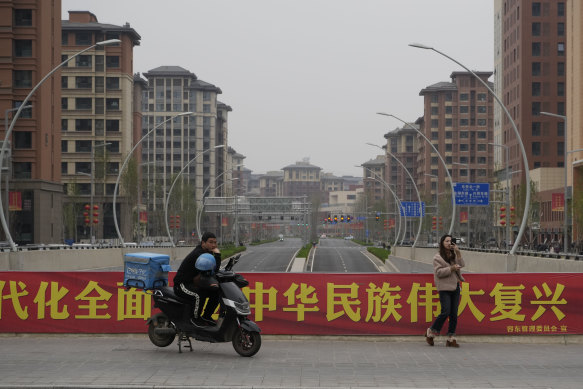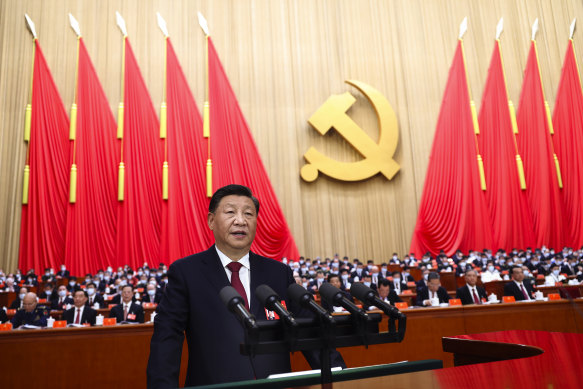This was published 1 year ago
Opinion
China hits its growth target, but no one’s impressed
Stephen Bartholomeusz
Senior business columnistChina hit, indeed marginally beat, its economic growth target last year. Its sharemarkets, however, weren’t impressed.
The Shanghai Shenzhen CSI 300 Index slumped more than 2 per cent overnight, taking its fall over the past 12 months to almost 22 per cent. Hong Kong’s Hang Sen China Enterprises index is down almost 4 per cent, taking its fall over the past year to more than 30 per cent.

Excluding the worst of the pandemic years, China’s GDP growth rate is the lowest in decades.Credit: AP
The markets’ reactions to the confirmation that China’s GDP rose 5.2 per cent last year might appear counter-intuitive, but what they really signal is that the headline number isn’t quite what it seems, nor is it reflective of the deep-seated problems within the economy.
Excluding the worst of the pandemic years, the growth rate is the lowest in decades. Moreover, because the base year of 2022 was a pandemic year in which China posted growth of (by its standards) a meagre 3 per cent, even a modest rebound was going to produce an apparently solid number.
It is instructive, given the natural rebound that occurred once the country’s harsh zero-COVID restrictions were lifted late in 2022, that to get to the official target of about 5 per cent growth last year China’s policymakers had to implement a series of (relatively small-scale) stimulus programs last year. If the 2022 data could be normalised to take out the impact of the pandemic, the growth rate – even with the stimulus measures – would have looked anaemic.
It will be interesting to see if the policymakers stick to a target of around 5 per cent for this year when they unveil it at their National Party Congress in March because that would probably require much larger and probably quite different stimulus measures, including massive infusions of cash to households to generate more consumption.
That’s because the underlying causes of China’s economic weakness are proving stubborn and, to some degree, structural.
At the core of the challenges confronting Beijing are the legacies of its past economic strategies. In the post-financial crisis era, growth has been propped up by massive state-directed investment in infrastructure and property development.
Over-investment in infrastructure and the implosion of the over-leveraged property sector has left China with a lot of unproductive investment and massive losses for financiers, households and local governments reliant on income from property sales.
The data released on Wednesday shows that the conditions in real estate continue to deteriorate. Indeed, the December-quarter data shows the prices of new homes, which fell 0.89 per cent last year, are falling at an accelerating rate.
Property investment was down nearly 10 per cent last year, new construction starts were more than 20 per cent lower and home sales by value were down about 6 per cent – all from a weak 2022 base.
The numbers say that Beijing, despite offering some funding support to key developers and incentives, has yet to stabilise a sector that was a key growth engine for the economy until President Xi Jinping’s well-intentioned policy of “three red lines”, or restrictions on property developers’ debt levels.
The wealth effects of the savage downturn in the property market on China’s middle-class homeowners and investors have depressed confidence and consumption, and the overhang of uncompleted developments and excess housing inventory will weigh on the economy for years to come.
The depressed state of the property sector will also hurt China’s local governments, which are dependent on property income to fund activity in their regions, and represent an ongoing threat to the stability of China’s vast and opaque shadow banking sector.
The challenges for Xi and his economic advisers aren’t confined to the continuing decline in property prices and activity.
In an attempt to avoid the mistakes of the past they may be repeating them. Rather than resort to the traditional approach of stimulating activity (for obvious and sensible reasons), much of the effort to boost the economy last year was directed at investments in manufacturing.
Amid relatively weak domestic demand, a slowing global economy and increasing trade friction with its major trade partners in the US and Europe, China’s factories are experiencing significant levels of excess capacity.
Some of the sectors targeted for Beijing’s financial support – like electric vehicles, batteries and renewables – have grown and are growing rapidly. China is the world’s dominant EV, battery and solar manufacturer.
Those sectors, however, are increasingly reliant on export markets in countries more focused on economic and supply chain security after the experience of the pandemic, increasingly concerned about state-subsidised imports and their impact on their own manufacturing bases and, in an environment of heightened geopolitical tensions, trying to “de-link” themselves from their over-dependence on China for the supply of strategic products.
Those tensions, the messy state of the national economy, China’s toughened but opaque anti-espionage regime, its crackdown on its big technology companies, the unpredictability of Beijing’s policymaking in recent years and the disinflation the economy is experiencing are all having an impact on the investment climate.
Fixed asset investment grew only 3 per cent last year. Private investment was down 0.4 per cent. For the first time in living memory, foreign direct investment turned negative in the second half of last year – despite a concerted effort by China to encourage international investors, more foreign capital was withdrawn than invested.
With excess economic capacity, cautious consumers and disinflation that’s a couple of basis points away from deflation, there are high levels of youth unemployment.

President Xi Jinping and his policymakers could stick to a growth target of around 5 per cent at their National Party Congress in March.Credit: AP
China stopped publishing youth unemployment numbers last year after they topped 21 per cent, but has now resumed releasing them – after changing the methodology to exclude university and school students.
The jobless rate for those aged between 16 and 24 is now 14.9 per cent, according to the new data. Had the previous approach been maintained, that rate might have been in the mid-20s, some analysts estimate.
The longer-term picture within which China’s economy is trying to evolve contains its own major demographic challenges.
Despite a range of incentives for women to have babies – tax incentives, cash, subsidised housing and calls to do their patriotic duty – China’s population shrank for the second year in a row, declining by a net 2.08 million.
A shrinking and rapidly ageing population, an economy with structural challenges and on the brink of a dangerous deflation and debt cycle and its edgier relationship with the West will weigh on China’s attempt to avoid the middle-income trap that inevitably confronts developing economies, and on its geopolitical ambitions.
Xi Jinping was right when he recognised that China’s old economic model was flawed and unsustainable. The path from the old model to the new, however, is proving more problematic and complex than he might have envisaged.
The Business Briefing newsletter delivers major stories, exclusive coverage and expert opinion. Sign up to get it every weekday morning.